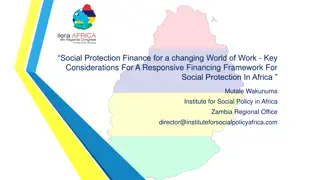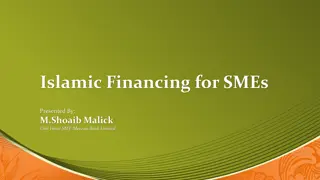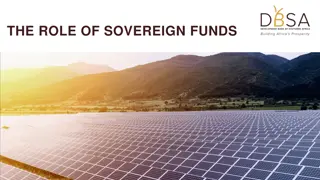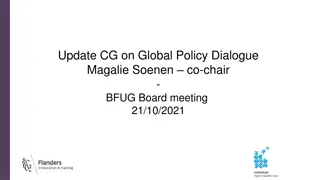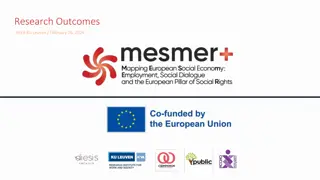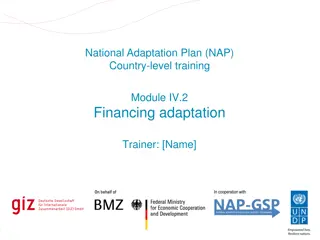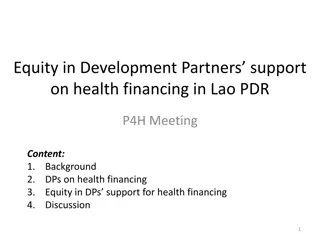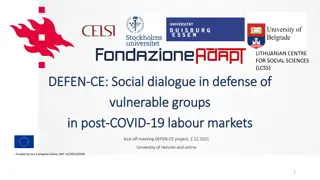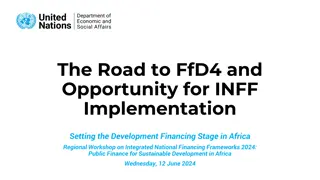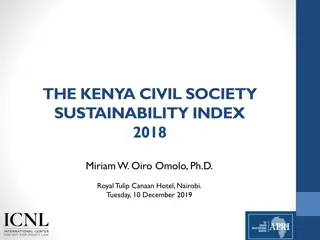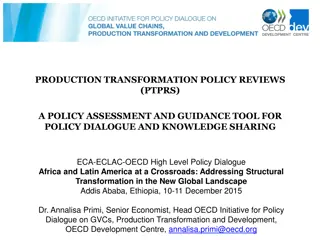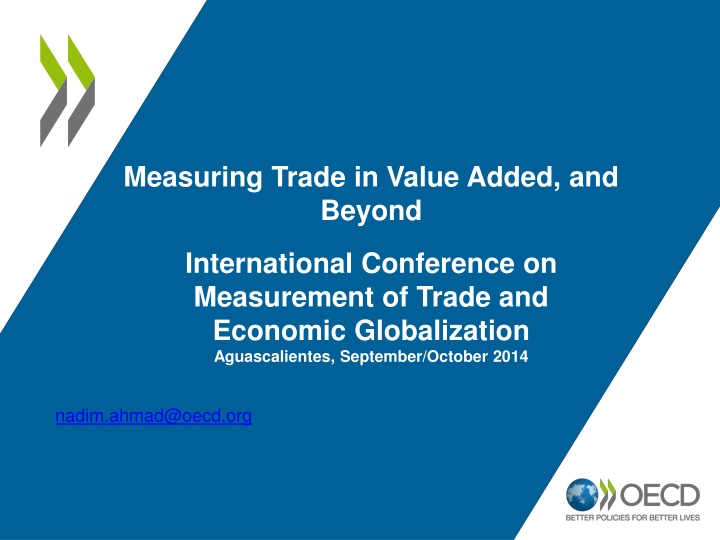
High-Level Policy Dialogue on Development Planning in Africa: Financing Sustainable Goals
Key discussions on financing the Sustainable Development Goals in Africa, including economic implications, funding sources, challenges, and macroeconomic developments. Recommendations for effective resource mobilization strategies to integrate SDGs into national development plans. Emphasis on the need for African countries to assess financing requirements and funding instruments for SDGs and Agenda 2063. Insights from the 2017 HLPD in Abuja and the Third International Conference on Financing for Development. Images and graphs provide a visual overview of recent macroeconomic trends in Africa.
Download Presentation

Please find below an Image/Link to download the presentation.
The content on the website is provided AS IS for your information and personal use only. It may not be sold, licensed, or shared on other websites without obtaining consent from the author. If you encounter any issues during the download, it is possible that the publisher has removed the file from their server.
You are allowed to download the files provided on this website for personal or commercial use, subject to the condition that they are used lawfully. All files are the property of their respective owners.
The content on the website is provided AS IS for your information and personal use only. It may not be sold, licensed, or shared on other websites without obtaining consent from the author.
E N D
Presentation Transcript
Measuring Trade in Value Added, and Beyond International Conference on Measurement of Trade and Economic Globalization Aguascalientes, September/October 2014 nadim.ahmad@oecd.org
An Interconnected World.. Increasing: International Fragmentation of Production within a Global Factory Role of MNEs Transfer pricing, Intellectual property flows, Supply Mode 3 And New types of Producers Factoryless, Processors, SPEs Complicating our ability to measure activity 2
.and Interpretable? statistics... Double counting of trade Who trades with who? Who s creating growth? Imports: good or bad? Double counting of FDI Capital-in-transit .. Real FDI? Blurring line between GNI and GDP 3
..produced with Disconnected sources Stove pipes: Business Registers SBS, NA, FATs, TiS?, FDI? Trade Registers Merchandise, TiS? Interconnected world but disconnected data Within countries And across With potentially misleading results and imperfect policies 4
How are we responding? Interconnected economies > Interconnected (integrated) statistics BDM4 Real FDI.. (double counting via SPEs) Linking Trade and Business Registers (TEC) and (TEC+ > ownership) to improve national coherence TiVA to improve international coherence and provide interpretability for global phenomena 5
What is TiVA: a statistical initiative A means to better reflect global interdependencies Country Country Country Gross exports (110) B Gross exports (intermediates) (100) C A Value-added (10) Value-added (100) Using a global IO table 6
What is TiVA: A response to policy demands To name but two of many: From the G20 starting with Los Cabos, 2012 And Trade Ministers (OECD MCM: strong call in both 2013-2014) 7
What is TiVA: A collective effort Launched in 2013 by the OECD and WTO in close collaboration with other agencies: USITC, IDE-JETRO, MOFCOM And through the OECD s WP on Trade, National Accounts, Industry and Innovation and Trade Committee. with OECD co-ordinating further international institutionalisation MoU being developed with Eurostat, Formal collaboration with APEC, Active collaboration with UNESCWA and UNECLAC And planned collaboration with African Development Bank to start in the next few weeks Given high priority by the OECD Committee of Statistics and Statistical Policy, and mainstreamed, with significant resources, into the OECD s core statistical work programme. 8
What is the output? A series of global IO tables: Currently 1995, 2000, 2005, 2008, 2009, 2010, 2011 (available Nov 2014) Updated annually With a series of derived indicators available on OECD.Stat 9
10 The current OECD Inter-Country I-O model 57 economies + Row, 1995-2009, 18 sectors OECD All OECD 34 countries Brazil, China, India, Indonesia, Russian Federation, South Africa Bulgaria, Cyprus, Latvia, Lithuania, Malta, Romania Argentina, Saudi Arabia Brunei Darussalam, Cambodia, Malaysia, Philippines, Singapore, Thailand, Viet Nam Chinese Taipei, Hong Kong China Rest of the World BRIICS Other EU27 Other G20 Other South Eastern Asia Other Eastern Asia Other November 2014: Plus, Colombia, Costa Rica, Croatia, Tunisia and 2010 34 sectors released
TiVA 2014 Industry List IO Industries Industry ISIC Rev.3 Agriculture, hunting, forestry and fishing Mining and quarrying Food products, beverages and tobacco Textiles, textile products, leather and footwear Wood and products of wood and cork Pulp, paper, paper products, printing and publishing Coke, refined petroleum products and nuclear fuel Chemicals and chemical products Rubber and plastics products Other non-metallic mineral products Basic metals Fabricated metal products except machinery and equipment Machinery and equipment n.e.c 01t05 10t14 15t16 17t19 20 21t22 23 24 25 26 27 28 29 1 2 3 4 5 6 7 8 9 10 11 12 13 30,32,33 14 Computer, electronic and optical products Electrical machinery and apparatus n.e.c Motor vehicles, trailers and semi-trailers Other transport equipment Manufacturing n.e.c; recycling Electricity, gas and water supply Construction Wholesale and retail trade; repairs Hotels and restaurants Transport and storage Post and telecommunications Finance and insurance Real estate activities Renting of machinery and equipment Computer and related activities Other Business Activities (incl. R&D) Public admin. and defence; compulsory social security Education Health and social work Other community, social and personal services Private households with employed persons 31 34 35 15 16 17 18 19 20 21 22 23 24 25 26 27 28 29 30 31 32 33 34 36t37 40t41 45 50t52 55 60t63 64 65t67 70 71 72 73, 74 75 80 85 90t93 95 12
WHAT DOES THE LATEST RELEASE TELL US 13
Highlights Intermediate imports embodied in exports, 2009 % of total intermediate imports 90 Total Exports require imports 80 Electronics 70 Transport equipment 60 50 40 30 20 10 0 United States Japan Mexico Germany China United Kingdom Korea Czech Republic Hungary 70 Import content of Exports 60 2009 1995 50 40 Growing fragmentation 30 20 10 0 VNM LTU ARG CAN THA KHM HKG LVA FRA IRL LUX HUN SVN TUR CYP ZAF SVK BGR NOR IDN USA SGP CZE MYS FIN KOR PHL BEL DNK AUT GRC CHL MLT SWE EST CHN CHE IND ESP ITA GBR AUS SAU NLD JPN ISR MEX POL NZL ROW BRN RUS TWN BRA ISL PRT DEU ROU 14
Services matter!..........China 90.0 Domestic content Foreign content Total 1995 80.0 70.0 60.0 50.0 40.0 30.0 20.0 10.0 0.0 CAN JPN KOR CHN CZE FIN CHE SVN IDN LUX SWE PRT FRA CHL AUT ISL RUS ZAF TUR IND DNK ESP NLD BEL POL DEU NOR AUS ITA EST HUN ISR GBR GRC SVK BRA IRL MEX USA NZL Foreign service contents Domestic service contents 1995 Total 30% 20% 10% 0% Chemicals & equipment equipment Transport Food products Textiles & apparel manufactures Machinery Electrical Agriculture Mining Basic metals Wood & paper minerals Other 15
Design, R&D, software etc becoming more important - Services content of transport equipment 50 Foreign Domestic 40 30 20 10 0 2009 1995 2009 1995 2009 1995 2009 1995 2009 1995 2009 1995 2009 1995 2009 1995 2009 1995 2009 1995 2009 1995 2009 1995 2009 1995 2009 1995 FRA DEU ITA JPN KOR MEX SVK ESP SWE GBR USA BRA CHN IDN 16
Geography remains important Rest of the world, 4.4% Asia, 3.4% Rest of the world, 5.1% OtherEuro pe, 16.3% Asia, 4.4% OtherEurop e, 14.8% France, 2.1% UK, 2.4% Italy, 3.2% Domestic, 69.1% Domestic, 60.7% US, 3.6% US, 2.4% Germany, 8.2% Germany: Motor vehicles, 2009 France: Motor vehicles, 2009 Rest of the world, 9.9% Rest of the world, 6.1% Other Asia, 6.8% Other Asia, 8.3% Europe, 7.4% Europe, 5.6% Japan, 4.1% Domestic, 40.6% Japan, 9.4% Domestic, 55.4% Chinese Taipei, 4.7% China, 9.6% China, 12.1% US, 20.1% Mexico: Electronics, 2009 Korea: Electronics, 2009 17
Trade patterns change: China Gross exports (EXGRSH) Domestic value added in foreign final demand (FDDVASH) 30.0 25.0 20.0 15.0 10.0 5.0 0.0 USA JPN DEU GBR FRA CAN KOR RUS ITA AUS IND ESP MEX NLD HKG Gross imports (IMGRSH) Foreign value added in domestic final demand (FDFVASH) 15.0 10.0 5.0 0.0 USA JPN DEU KOR AUS SAU TWN RUS BRA FRA IND ITA GBR CAN MYS 2009 Gross Trade surplus/deficit (TSGR) 2009 Value Added surplus/deficit (TSVAFD) 250,000 200,000 150,000 100,000 50,000 0 -50,000 -100,000 18 USA GBR MEX FRA NLD VNM THA JPN BRA MYS TWN KOR
And throughout Factory Asia 40 Exports to China: Gross and Value-added terms, % of total 35 Value-Added Gross 30 25 20 15 10 5 0 2009 1995 2009 1995 2009 1995 2009 1995 2009 1995 2009 1995 2009 1995 2009 1995 2009 1995 2009 1995 2009 1995 2009 1995 2009 1995 Chinese Taipei Japan Korea Malaysia Thailand Hong Kong, China Singapore Philippines India Indonesia Viet Nam Cambodia Brunei Darussalam 19
In general the more distant the countries the more likely that gross trade statistics underestimate the relationship Change in trade shares based on Value-Added in United States Brazil 10 1 Exports Imports 0.5 8 0 6 MEX ZAF RUS CAN IDN ARG TWN AUS CHL MYS USA EU27 CHN THA IND ISR KHM JPN TUR KOR PHL VNM -0.5 4 -1 2 -1.5 0 -2 MEX ZAF IDN CAN RUS TWN ARG AUS SAU MYS BRA EU27 CHN IND THA KHM ISR JPN TUR KOR PHL VNM -2 -2.5 -4 -3 Exports Imports -6 -3.5 20
Foreign value added in Chinese Electrical equipment, by originating region and industry, % East and S.E. Asia Europe North America Other regions South America 14.0 12.0 10.0 8.0 6.0 4.0 2.0 0.0 1995 2009 1995 2009 1995 2009 1995 2009 1995 2009 1995 2009 1995 2009 1995 2009 1995 2009 1995 2009 Mining Chemicals & minerals Basic metals Electrical equipment Transport equipment Wholesale and retail Transport & telecoms Finance & insurance Business services Other 21
ESTIMATION? 22
OECD Inter-country I-O table National I-O/SU tables Production linkage Final expenditure Income (Value-added) Import procurement info Bilateral Trade Database by industry and end-use categories (intermediates, capital and consumption goods) + 61 countries, 1995-2010/11, 34 sectors, consistent with SNA Country A Country B Final Demand Sector 1 Z11 Z21 Z11 Z21 NTZ1 TIZ1 VL1 VO1 VT1 X1 Sector 2 Z12 Z22 Z12 Z22 NTZ2 TIZ2 VL2 VO2 VT2 X2 Sector 1 Z11 Z21 Z11 Z21 NTZ1 TIZ1 VL1 VO1 VT1 X1 Sector 2 Z12 Z22 Z12 Z22 NTZ2 TIZ2 VL2 VO2 VT2 X2 Country A Country B F1 F2 F1 F2 NTFA TIFA AA AA AB AB AA AB Sector 1: Goods Sector 2: Services Sector 1: Goods Sector 2: Services F1 F2 F1 F2 NTFB TIFB Country A AA AA AB AB AA AB BA BA BB BB BA BB Country B BA BA BB BB BA BB A A B B Tax less subsidy on products International trade margin and insurance A A B B A A B B Value- Added Labor compensation Operating surplus Tax less subsidy on production A A B B A A B B 2 3 A A B B Output
What are the challenges? Data: Availability Coherence 24
Bilateral Trade statistics An international IO table requires high quality international trade statistics Asymmetries & missing data Re-exports Additional information on cif/fob adjustments Rules for dealing with confidentiality Supporting Import flow matrices Estimates of non-residents and residents expenditure abroad An ability to reconcile merchandise trade/TIS flows with National Accounts SU and IO tables. 25
Merchandise trade asymmetries - examples Top 5 export asymmetries (countries) for Costa Rica Top 5 import asymmetries (countries) for Costa Rica Reported exports 4,307 Mirror imports 12,303 5,270 4,114 3,259 746 % RA (abs) 48.1% 88.3% 65.8% 82.4% 84.6% Reported imports 9,519 1,446 Mirror exports 7,198 902 954 993 231 % RA (abs) 13.9% 23.2% 26.0% 8.9% 68.0% X-M M-X 1 USA 2 China 3 Netherlands 4 Mexico 5 Singapore -7,996 -4,944 -3,264 -2,944 -684 1 USA 2 China 3 Japan 4 Mexico 5 Israel 2,321 544 -393 194 -187 327 850 315 62 561 1,187 44 Top 5 export asymmetries (countries) for Colombia Top 5 import asymmetries (countries) for Colombia Reported exports 22,216 Mirror imports 25,225 1,782 1,355 1,639 % RA (abs) 6.3% 63.7% 29.8% 18.4% 93.7% Reported imports 9,565 14,140 6,362 1,133 1,288 Mirror exports 6,229 16,395 5,592 829 1,468 % RA (abs) 21.1% 7.4% 6.4% 15.5% 6.5% X-M M-X 1 USA 2 Germany 3 Netherlands 4 United Kingdom 5 Israel -3,008 -1,387 1,148 -510 509 1 China 2 USA 3 Mexico 4 Canada 5 Korea 3,336 -2,254 770 304 -180 395 2,503 1,129 526 17 Top 5 export asymmetries (countries) for Korea Top 5 import asymmetries (countries) for Korea Reported exports 134,322 9,042 7,510 2,827 22,888 Mirror imports 168,728 13,341 10,838 5,601 25,626 % RA (abs) 11.4% 19.2% 18.1% 32.9% 5.6% Reported imports 9,676 80,782 64,363 11,354 22,988 Mirror exports 16,576 87,674 61,538 13,865 20,541 % RA (abs) 26.3% 4.1% 2.2% 10.0% 5.6% X-M M-X 1 China 2 Mexico 3 Germany 4 France 5 Singapore -34,406 -4,299 -3,328 -2,774 -2,738 1 Singapore 2 China 3 Japan 4 Russia 5 Australia -6,900 -6,892 2,825 -2,512 2,447 26
Services Trade asymmetries - examples Top 5 services export asymmetries (countries) for United Kingdom Reported exports Top 5 services import asymmetries (countries) for United Kingdom Reported imports Mirror imports % RA (abs) Mirror exports % RA (abs) X-M M-X 1 USA 2 Germany 3 Spain 4 Australia 5 Korea 60,147 16,666 8,375 8,979 2,173 45,669 26,349 17,489 5,271 5,096 14,478 -9,683 -9,115 3,708 -2,924 13.7% 22.5% 35.2% 26.0% 40.2% 1 USA 2 Ireland 3 Germany 4 Spain 5 Netherlands 29,038 6,391 14,018 15,008 6,244 52,970 20,924 28,277 26,614 13,347 -23,932 -14,533 -14,259 -11,606 -7,103 29.2% 53.2% 33.7% 27.9% 36.3% Top 5 services export asymmetries (countries) for Korea Reported exports Top 5 services import asymmetries (countries) for Korea Reported imports Mirror imports % RA (abs) Mirror exports % RA (abs) X-M 4,833 3,150 1,936 1,007 -399 M-X 1 USA 2 United Kingdom 3 Japan 4 Canada 5 France 15,858 3,765 9,954 1,362 837 11,025 615 8,018 355 1,236 18.0% 71.9% 10.8% 58.6% 19.2% 1 USA 2 Japan 3 United Kingdom 4 Germany 5 France 26,831 8,934 5,096 4,315 1,609 16,767 3,465 2,173 2,878 2,499 10,064 5,469 2,924 1,437 -890 23.1% 44.1% 40.2% 20.0% 21.7% Top 5 services export asymmetries (countries) for Luxembourg Reported exports Top 5 services import asymmetries (countries) for Luxembourg Reported imports Mirror imports % RA (abs) Mirror exports % RA (abs) X-M 7,087 6,850 -6,118 2,496 2,250 M-X 1 Germany 2 United Kingdom 3 Ireland 4 Belgium 5 France 12,224 9,679 988 6,349 7,262 5,137 2,829 7,106 3,853 5,013 40.8% 54.8% 75.6% 24.5% 18.3% 1 Germany 2 USA 3 Italy 4 France 5 United Kingdom 5,600 2,610 2,614 4,139 5,141 9,994 6,018 1,064 5,622 4,031 -4,393 -3,408 1,551 -1,483 1,110 28.2% 39.5% 42.2% 15.2% 12.1% 27
National Supply Use and Input- Output tables Supply-Use: Make and Use tables at Purchasers and Basic Prices .. preferably every year but if not: at the very least periodically and recent, with supporting National Accounts information on value-added and output by industry and all categories of final demand And supporting import flow tables Plus periodical IO tables 28
Whilst there are limitations to the widespread calculation of trade in value-added data, the OECD-WTO initiative is to be applauded for providing a more revealing look into global trade and integration and for paving the way for further development in this area. 31
No.strong demand for Jobs Skills? Information by ISCO? Investment? Creating a Trade-Investment Story 32
Jobs in the business sector* sustained by foreign final demand As a % of total business sector employment But where challenges exist in measuring relative productivity between exporting and non-exporting firms and where greater coherence between jobs and value-added data is needed * Business sector = ISIC Rev.3 divisions 10 to 74) Source: OECD, Science, Technology and Industry Scoreboard, 33 2013
Why Investment? Because value added does not always stick (compensation for use of knowledge based assets where increasingly registration is determined by tax environment) And Statistically, the line between trade in services and property income is becoming more blurred ..distorting value-added measures . Trade in services versus mode 3? 34
Value-Added of Foreign Affiliates share of national Total 2009 (ISIC B-N, ex K 60% 50% 40% 30% 20% 10% 0% 35
Chinas hi-tech exports 100% 90% Others 80% 70% Foreign wholly owned companies Sino-Foreign Joint Ventures Chinese State Owned 60% 50% 40% 30% 20% 10% 0% 2002 2003 2004 2005 2006 2007 2008 2009 Source: 36
The contribution of foreign affiliates to domestic value added in exports, 2009. Source: OECD AMNE and TiVA databases 37
Irelands VA to export ratios? 60% 50% 40% VA-Export (TiVA) Ratio Ex US affiliate GOS 30% 20% 10% 0% Chemicals ICT Total Economy Source: OECD illustrative estimates 38
Increase in US TiVA Trade balance, adjusted for US affiliate trade in Ireland, 2009 $bn 3.5 3 2.5 2 1.5 1 0.5 0 Belgium France Germany Italy Japan Spain United Kingdom Source: OECD illustrative estimates 39
Chinas Trade surplus with the US? 200 190 180 170 160 $62bn 150 140 130 $16bn 120 110 100 Gross VA EX US affiliate GOS in China exported to US EX US affiliate GOS in OECD consumed in China EX US affiliates GOS in other ASIA consumed in China EX other OECD affiliates GOS in China exported to US Source: OECD illustrative estimates 40
Planned extensions Jobs Skills? Information by ISCO? Investment? Creating a Trade-Investment Story Improving quality Dealing with heterogeneity 41
TiVA key assumptions (1) That all firms allocated to a particular industry have the same production function. (2)That for a given product, imports by industries (firms) are sourced from the same mix of countries. 42
But.... We know these assumptions don t generally hold (especially with 2008 SNA). Exporting firms typically import more And have higher labour productivity than non- exporters (in the same industry) Meaning that import content of export estimates are downward biased Requiring new approach to developing SU tables that better reflects today s global production: Linking and leveraging across existing datasets 43
Expert Group on Extended SU tables To create an integrated economic accounting framework for globalisation - mainstreaming-integrating FATS and TEC More detailed SU tables: Industries More heterogeneity: Foreign/Domestic, Export/non-export, S/M/L Imports With all products at fob and separate column for residents expenditure abroad Import use tables by main import partner Exports With non-residents expenditure and re-exports separately identified PLUS transparent adjustments for some non-observed items (e.g. own account agricultural production) Jobs by industry row Emissions by industry row new rows for property income flows: interest, distributed income of corporations, reinvested earnings on FDI, Investment income disbursements And, for BEPS: current taxes on income, wealth etc 44
Use Table Industry 1 Industry 2 Changes in Inventori es of which - non- residents expenditure FATS Foreign Domestic Foreign Domestic of which re-exports HHFC GGFC GFCF Vauables Exports Non- Exporter Non- Exporter Non- Exporter Non- Exporter Exporter Exporter Exporter Exporter Exporter Non-Exporter Exporter Non-Exporter Exporter Non-Exporter Exporter Non-Exporter Taxes on Products Subididies on Products Foreign Industry 1 With re-exports broken down, ideally, by destination (main partner countries/regions) Domestic Foreign Industry 2 Domestic Total Domestic intermediate Consumption Total imports Total intermediate Consumption Value-Added of which Mixed Income Compensation of Employees Gross Operating Surplus Other Taxes on Production Other Subsidies on Production Total Output of which own-account production of software own-account prodduction of R&D other own-account production 45
Import Use table Industry 1 Industry 2 of which: Residents expenditure abroad Changes in InventoriesVauables Exports Foreign Domestic Foreign Domestic HHFC GGFC GFCF Non- Exporter Non- Exporter Non- Exporter Non- Exporter Exporter Exporter Exporter Exporter Industry 1 Industry 2 Total imports Taxes/Subsidies on Imports With separate tables made available broken down by main country or region of origin groupings 46
Supply Table Memorandum item Industry 1 Industry 2 Total Domestic Supply at Basic Prices Taxes and Subsidies on Products of which import taxes / subsidies Imports F.O.B Foreign Domestic Foreign Domestic Total Supply Non- Exporter Non- Exporter Non- Exporter Non- Exporter Exporter Exporter Exporter Exporter Exporter Non-Exporter Exporter Non-Exporter Exporter Non-Exporter Exporter Non-Exporter Total of which Foreign Industry 1 Domestic Foreign Industry 2 Domestic own-account production of software own-account prodduction of R&D other own-account production 47
Extensions? Industry 1 Industry 2 Foreign Domestic Foreign Domestic Non- Exporter Non- Exporter Non- Exporter Non- Exporter Exporter Exporter Exporter Exporter Property income payments - to abraod of which Interest Distributed Income of Corporations Reinvested Earnings on FDI Investment Income Disbursements Property Income payments - to abroad of which Interest Distributed Income of Corporations Reinvested Earnings on FDI Investment Income Disbursements Current taxes on income and wealth Employment Employees Hours worked Co2 emissions 48
Summary Much has already been done But plenty more to do With strong support and mandates from G20 and Trade Ministers and CSSP, OECD will continue to: Ensure that its WP meetings serve this agenda Devote considerable resources to achieving the broader needs of the international statistical community Leverage its links between Policy and Statistics Develop the international network to mainstream global SU tables and extensions to national SU tables. For more info see: oe.cd/tiva 49

